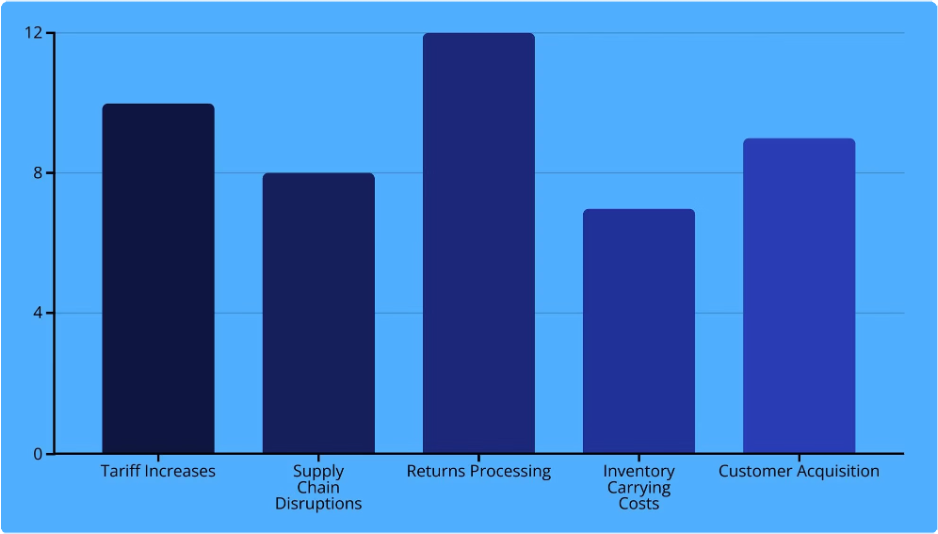Boston, MA – The eTail Boston trade show, held August 11-14, revealed a decisive shift in retail technology investment priorities, with artificial intelligence emerging as the overwhelming focus for industry leaders. According to comprehensive attendee survey data, 82% of retail executives identified AI as their top investment priority, tied with customer experience optimization, signaling a fundamental transformation in how the industry approaches operational challenges.
The survey findings revealed that 79% of attendees prioritized brand and content marketing, while 72% focused on data and analytics capabilities. Notably, 87% of surveyed companies indicated readiness to purchase solutions within the next 12 months, demonstrating unprecedented urgency in AI adoption.
AI-Powered Returns Prevention Takes Center Stage
The convergence of these priorities was prominently showcased in the keynote presentation "From Reactive to Proactive: How AI is Revolutionizing Returns Prevention" by Christine Bradford, VP of Customer Success at Returnalyze. Bradford addressed one of retail's most persistent challenges while demonstrating how AI solutions deliver measurable results across multiple business priorities.
Bradford opened with compelling industry data: returns now represent a $890 billion annual cost to the retail industry, with online return rates of 30% compared to just 9% for physical stores. Most significantly, 73% of returns are "controllable," occurring due to reasons retailers can influence, such as product damage, incorrect sizing, or poor product descriptions.
"Seven in ten retailers do not have a good understanding of the root cause of their returns, and 86% say returns reduction technology is too difficult to implement," Bradford explained, highlighting how AI changes this equation through real-time data synthesis and pattern recognition across thousands of variables.
Dramatic Results Drive Adoption
Bradford presented concrete results from Returnalyze's AI platform: "We're consistently seeing up to 15-20% reductions in return rates, with results visible within 90 days and millions of dollars in recovered revenue." These outcomes directly address customer experience priorities while capturing significant profit opportunities.

The keynote featured compelling case studies, including J.Crew's implementation, where AI-driven insights enable real-time product page adjustments and merchandising optimization, resulting in significant margin improvement alongside greater customer satisfaction and loyalty. Another case study showed how Abercrombie & Fitch used AI to identify that US size guides in international markets caused confusion, leading to market-specific solutions that reduced returns.
Industry Validation and Strategic Framework
Bradford's presentation included validation from First Analysis E-commerce Optimization Study: "We believe it is possible for online sellers to use return prevention technology to drive e-commerce return rates down to match traditional retail rates, moving from 3:1 to 1:1."
The keynote revealed a striking leadership gap: 97% of retailers lack executive ownership for returns prevention. Bradford's framework for success outlined a five-step process: automated insights and recommendations, action prioritization by revenue opportunity, assignment of ownership, execution tracking, and impact measurement.
Competitive Advantage Through AI
Bradford emphasized how AI-powered returns prevention addresses multiple eTail Boston priorities simultaneously. For executives focused on AI (82% of attendees), the platform delivers sophisticated machine learning and predictive analytics. For those prioritizing customer experience (82%), it prevents negative experiences that drive customer churn. For the 72% focused on analytics, it provides actionable insights across merchandising and operations.
"While competitors absorb return costs as 'the cost of doing business,' prevention leaders redirect these losses into market expansion, customer acquisition, and innovation investment," Bradford concluded, positioning returns prevention as revenue generation rather than cost center optimization.
Industry Transformation Accelerates
The emphasis on AI at eTail Boston reflects broader industry recognition that technology solutions can address operational challenges while improving customer experience. Bradford's presentation illustrated how early adopters are creating sustainable competitive advantages in an increasingly challenging retail environment.
Bradford's closing message captured the strategic imperative: "The retailers thriving in today's challenging environment aren't just managing returns more efficiently – they're preventing them strategically. The question facing retail leadership isn't whether to address returns prevention, but whether to lead this transformation or follow competitors who recognize its strategic imperative."
The eTail Boston survey results indicate that AI-powered solutions addressing core operational challenges while enhancing customer experience will remain top investment priorities for senior retail executives seeking measurable business impact and competitive differentiation.
Retail executives interested in learning more about AI-powered returns prevention can contact Returnalyze at sales@returnalyze.com or visit returnalyze.com to explore how the platform addresses the strategic priorities identified by eTail Boston attendees.
Frequently Asked Questions (FAQs)
1) What were the top technology investment priorities at eTail Boston 2025?
The event survey revealed AI as the clear front-runner, with 82% of retail executives ranking AI solutions as a top investment, tied with customer experience optimization. Brand and content marketing followed at 79%, and data & analytics at 72%. Notably, 87% of surveyed companies signaled they’re ready to purchase solutions within the next 12 months, highlighting a decisive, near-term shift toward AI-driven transformation across merchandising, operations, and CX.
2) Why is AI-powered returns prevention so important right now?
Returns have become a massive drag on profitability and customer loyalty. Industry figures cited at the show peg retail’s annual return cost at $890 billion, with online return rates near 30% vs. ~9% in stores—and critically, an estimated 73% of returns are controllable (tied to factors retailers can influence, like content accuracy, sizing, quality, and fulfillment). AI changes the equation by surfacing root causes, prioritizing actions by revenue impact, and enabling teams to prevent negative outcomes before they occur.
3) What results are retailers seeing from AI-driven returns prevention?
According to the keynote, retailers are consistently achieving 15–20% reductions in return rates, often within 90 days, thereby unlocking millions of dollars in recovered revenue. Case studies included J.Crew, which uses real-time insights to adjust product pages and merchandising for margin lift and higher satisfaction, and Abercrombie & Fitch, which reduced returns by localizing sizing information after detecting confusion from U.S. size guides in international markets.
4) What leadership and process gaps did the keynote highlight—and how can retailers close them?
A standout finding was a 97% leadership gap: most retailers lack clear executive ownership for returns prevention. The recommended framework is a five-step loop: (1) automated insights and recommendations, (2) action prioritization by revenue opportunity, (3) assignment of ownership, (4) execution tracking, and (5) impact measurement. This creates accountability, accelerates time-to-value, and aligns initiatives with the metrics that matter for the C-suite.
5) How does returns prevention connect to broader eTail priorities like CX and analytics?
Returns prevention is a force multiplier: for the 82% prioritizing AI, it delivers machine learning and predictive analytics; for leaders focused on customer experience, it prevents the friction that drives churn; and for the 72% prioritizing analytics, it turns raw data into actionable, prioritized insights across merchandising and operations. In short, it’s not a siloed project—it’s a strategic lever that advances multiple investment themes at once.
6) What’s the strategic takeaway for executives evaluating AI investments post-eTail Boston?
The message was direct: the winners aren’t merely processing returns more efficiently—they’re preventing them strategically and reallocating the saved costs into growth plays, such as market expansion, customer acquisition, and innovation. With buyers actively budgeting for AI in the next year, operationalizing returns prevention now can create a durable competitive advantage while supporting short-term profitability goals


